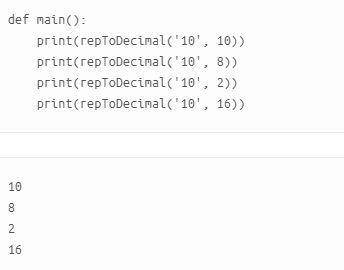
Computers and Technology, 04.03.2021 02:00 NetherisIsTheQueen
In Chapter 4, we developed an algorithm for converting from binary to decimal. You can generalize this algorithm to work for a representation in any base. Instead of using a power of 2, you will write a program that converts any base between 2 and 16. Recall that for numbers 10 - 15 we use letters A - F.
In convert. py, define a function named repToDecimal that expects two arguments, a string, and an integer. The second argument should be the base. For example, repToDecimal("10", 8) returns 8, whereas repToDecimal("10", 16) returns 16.
The function should use a lookup table to find the value of any digit. Make sure that this table (it is actually a dictionary) is initialized before the function is defined.
For its keys, use the 10 decimal digits (all strings) and the letters A . . . F (all uppercase). The value stored with each key should be the integer that the digit represents. (The letter A associates with the integer value 10, and so on.)
The main loop of the function should convert each digit to uppercase, look up its value in the table, and use this value in the computation.
A main function that tests the conversion function with numbers in several bases has been provided.
An example of main and correct output is shown below:


Answers: 3


Another question on Computers and Technology

Computers and Technology, 22.06.2019 19:30
When creating a presentation in libre office impress, where does the editing of slides take place? a. the slides panel b. the center panel c. the tasks panel, under the masters pages tab d. the tasks panel, under the layouts tab
Answers: 3

Computers and Technology, 22.06.2019 19:30
Avariable definition defines the name of a variable that will be used in a program, as well as
Answers: 3

Computers and Technology, 23.06.2019 12:00
If you embed a word table into powerpoint, what happens when you make edits to the embedded data? a. edits made to embedded data change the data in the source file; however, edits made to the source file will not be reflected in the embedded data. b. edits made to embedded data will change the data in the source file, and edits made to the source file will be reflected in the embedded data. c. edits made to embedded data don't change the data in the source file, nor will edits made to the source file be reflected in the embedded data. d. edits made to embedded data don't change the data in the source file; however, edits made to the source file will be reflected in the embedded data.
Answers: 1

Computers and Technology, 24.06.2019 07:50
Write a defining table and then a program that determines if you can sleep in or not. your program should get all its input from your computer’s clock. on all weekdays (monday through friday) that are not holidays, your program should output “get up! ” on all other days (weekends and holidays), your program should output “sleep in.” the three holidays that your program must check for are january 1 (new year’s day), july 4 (u.s. independence day), and december 25 (christmas). you don’t need to include other holidays in your program because most other holidays do not occur on a fixed day each year.
Answers: 1
You know the right answer?
In Chapter 4, we developed an algorithm for converting from binary to decimal. You can generalize th...
Questions

Mathematics, 07.05.2021 07:30

History, 07.05.2021 07:30

Mathematics, 07.05.2021 07:30







History, 07.05.2021 07:30

Mathematics, 07.05.2021 07:30

Mathematics, 07.05.2021 07:30

Mathematics, 07.05.2021 07:30

Mathematics, 07.05.2021 07:30

Mathematics, 07.05.2021 07:30


Mathematics, 07.05.2021 07:30

History, 07.05.2021 07:30




